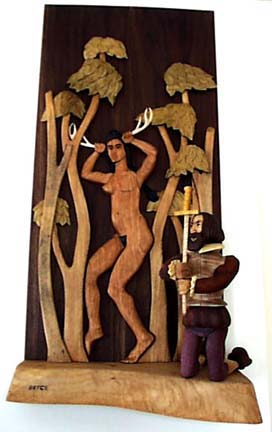Virginia
| Carving and composing architectural reliefs exposed me to a new mindset. I can feel a perceptual shift when I compare 2-dimensional images, and 3-dimensional images –– and I've attempted to play with the middleground between them. I've come to associate 3D images with individuated personalities and entities –– our isolate selves. 2D carvings seem to merge with the architecture –– are about figures in a wider context. At least for me. When Europen civilization (so called) encountered the Americas, Renaissance Christian man came face to face with pagan peoples wholly immersed in nature. I tried to portray this dicotomy by making Capt. Smith free-standing, and showing Pocahontas as part of the landscape. |
 |
| Smith was an astonishing character, with an epic career (as described in one of my journals). Despite his cross-cultural perceptiveness, Smith was still an Elizabethan soldier. His pose of warding off the pagan evil with his Christian sword, and his costume of breastplate and hose, depict his civilizing role. But he can't resist that sidelong look at the virgin landscape. As his post-Jamestown history shows, he was very much the isolated individual caught in the toils of the time. |
| Pocahontas as the Native American in shamanic sympathy with the woods is an image right out of Smith's own journals. But she, too, couldn't resist that sidelong look. She married Rolfe, sailed to England, became a favorite of the Queen, and died before she could return to America.
Here, then, are two Tricksters on the boundary. Their meeting changed the world. Smith propagandized about the New World –– inventing the name New England as a lure –– saying it was a place where everyman could make his own life. Pocahontas was enchanted by the Englishmen, and spent her last days in crinolines and lace. Virginia, as we know, became a tobacco plantation. |

